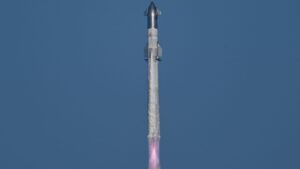SpaceX’s Starship Flight 6: A New Era in Space Exploration
On November 19, 2024, the world watched as SpaceX launched the sixth test flight of its groundbreaking Starship rocket from the company’s private facility, Starbase, near Boca Chica, Texas. While the flight was unmanned, it showcased significant advancements in rocket technology that could redefine our approach to space travel.
Key Highlights of the Flight
The Starship successfully ventured into space, circling half the Earth before reentering the atmosphere and splashing down in the Indian Ocean — a significant milestone as it marked the first daylight splashdown for the Starship. Notably, this launch also aimed to further test the capabilities of the rocket, including the ignition of an engine in space and the evaluation of new heatshield technologies.
However, one of the most anticipated components of the flight was the recovery of the "Super Heavy" booster. Originally, SpaceX planned to catch the booster using its launch tower’s arms after it detached from the Starship. Unfortunately, the booster did not meet the "commit criteria" necessary for a successful catch and instead splashed down in the Gulf of Mexico.
Pushing the Boundaries of Technology
SpaceX has been consistently pushing the envelope with each flight since the rocket’s inaugural tests began in April 2023. The company recently achieved a significant milestone by catching the Super Heavy booster during its previous launch in October. However, this flight was not without its challenges. Following the fifth flight, an internal discussion revealed that the booster nearly aborted the catch due to a timing issue, demonstrating the complex engineering challenges SpaceX faces at every junction.
Yet, SpaceX’s commitment to learning from its tests is unwavering. Following previous flights, the company made critical hardware upgrades to enhance the redundancy and structural integrity of the Super Heavy booster, indicating an adaptive approach to rocket design that sets it apart from traditional aerospace practices.
The Bigger Picture
Starship is not just another rocket; it represents a leap toward the future of space exploration. As the world’s tallest and most powerful rocket, Starship stands at a staggering 397 feet when fully stacked with its Super Heavy booster. It houses 33 Raptor engines that produce 16.7 million pounds of thrust — an impressive figure that outmatches that of NASA’s Space Launch System.
What’s more, Starship is pivotal to NASA’s Artemis program. With a multibillion-dollar contract awarded to SpaceX, Starship will serve as a crewed lunar lander, facilitating the return of astronauts to the Moon as part of humanity’s ongoing explorations beyond Earth.
Conclusion
As we witness the continuous developments of SpaceX’s Starship program, it is essential to recognize its role as a game-changer in the aerospace industry. By focusing on reusability and advanced technology, SpaceX is not just preparing for commercial space travel; it is setting the stage for the next era in human exploration.
Stay tuned to Extreme Investor Network for more insights and analyses on the future of space travel and the investments driving innovation in aerospace technology. Explore the potential that lies in the stars with us, as we uncover the stories of tomorrow’s breakthroughs today.

